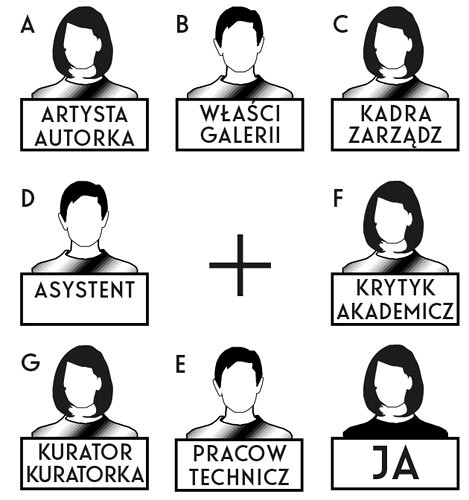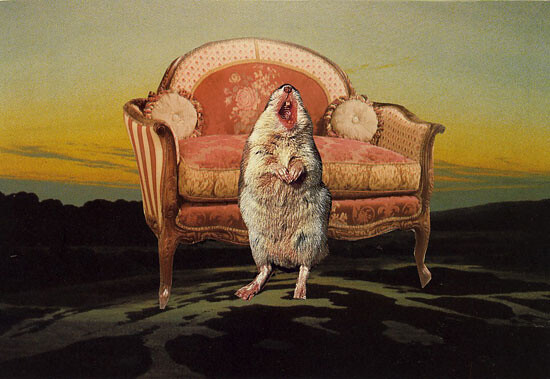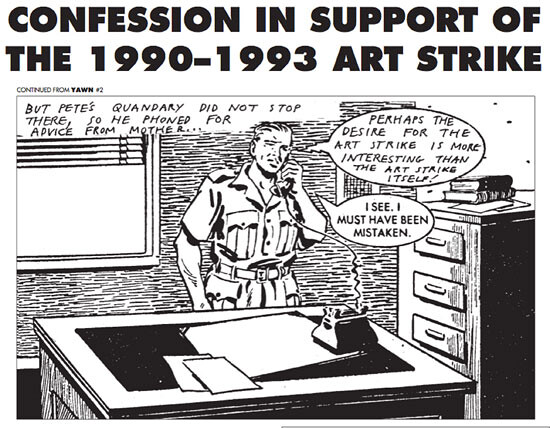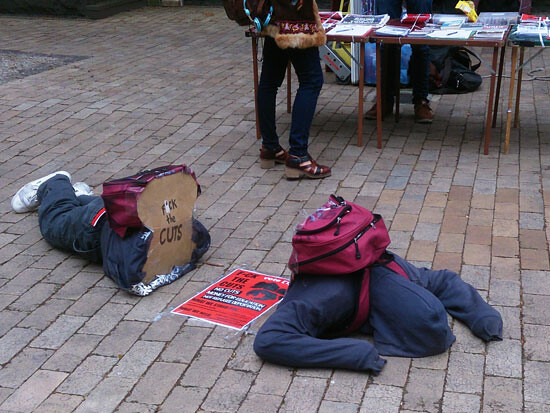What relationship is there between the work of art and communication? None at all. A work of art is not an instrument of communication. A work of art has nothing to do with communication. A work of art does not contain the least bit of information. In contrast, there is a fundamental affinity between a work of art and an act of resistance.
—Gilles Deleuze
After Art and Revolution, A Thousand Machines, and texts and interventions in defense of public education, heterotopias, and the right to movement, of which some have been published in the journal Transversal, the book Factories of Knowledge, Industries of Creativity appears as a summary of Gerald Raunig’s long-standing research into radical theories and practices of cultural resistance. Now Raunig’s two main inspirations, critical theory and French poststructuralism—in particular Foucault, Deleuze, and Guattari—are combined with post-operaist immanentism. The book includes a short afterword by Antonio Negri emphasizing the importance of this “countermelody” for building resistance and solidarity in the common. As I will argue, in this combination, all sides gain: operaismo obtains a concept of the common enriched by some aspects of the more traditional notion of the public; critical theory gains a way of overcoming the impasse of nostalgia; and poststructuralism benefits from a more materialist notion of critique and resistance, a vision of practice allowing the new heterotopias to come.
Gerald Raunig’s theorizing harkens back to the early days of the Frankfurt School, and not just in the way it takes the classical theme of the culture industry and reappropriates it for a Deleuzian theory of contemporary cognitive capitalism based on creative and affective labor. Indeed, its most striking similarity with the project of Adorno and Horkheimer lies in its capacity for theorizing contemporary social conflicts in a way that combines theories and practices—and often micropractices—in order to create inspiring theoretical machines that resemble Deleuze and Guattari’s war machines.
This aspect of the German philosophical tradition—the effort and capacity to be modern in the sense of building a critical, self-conscious discourse embracing the issues at the core of contemporary political conflicts, such as the conflict over the current transformation of public education—is paradoxically made possible by developing notions that derive from a very different, antitranscendental and materialist tradition. The questions formulated by Adorno and Horkheimer in their analysis of the culture industry resonate with Raunig’s critical observations concerning the recent neoliberal transformations of the university, in which quantitative measurements emphasizing immediate effectiveness replace qualitative criteria and the long perspective of the early days of the university. The so-called Bologna Process, which aims to unify university programs and measures of evaluation across EU countries, results in a highly technical approach to knowledge production and reduces the student-professor exchange to brief moments of grading rather than discussion, which prevailed before. The public mission of universities is replaced by the modus operandi of the factory, in which quickly measurable products and their “parameterization” replace debate and procesual approaches. The resistance to these processes—such as the Occupy movement, but also other protests, for example in London, Berkeley, and Krakow—not only try to halt the transformation of universities into corporations; they also offer lines of flight out of the profit-oriented, neoliberal main current.1 The Free/Slow University of Warsaw (WUW), a project organized by Kuba Szreder and other academics and curators, is an alternative to the instrumental approaches that dominate academia today. WUW tries to combine knowledge from the arts and sciences to allow workers from both fields to understand contemporary mechanisms of commodification. Analyzing contemporary modes of production, it calls upon practices of solidarity and resistance.2 Gerald Raunig was one of the first guests at the seminars offered by WUW. Later on, theorists, artists, and activists such as Martha Rosler, Luc Boltanski, Patricia Reed, and many others joined us in Warsaw to produce what I would call “counter-knowledges,” referring to the “counterpublics” suggested by Nancy Fraser.3


With his machinistic apparatus, however, Raunig remains far from the sentimental approaches of some liberal critiques of the recent transformations in the university and culture, in which the humanities should be preserved as some form of “art for art’s sake,” albeit deprived of any political signification.4 In Raunig’s analysis the university, and the humanities in particular, are a political matter, not because of their supposedly “disinterested beauty,” alienated from any social and political context, but precisely because they constituted a zone of critique, resistant to marketization and financialization, and they therefore enrich the cultural experience of contemporary individuals. His sharp sense of observation is at its best when formulating the twenty-eight tendencies of changing university, of which the twenty-sixth is as follows:
The university is becoming an actor in the intertwined strategies of the real estate market and infrastructure policy: the upgrading of the city districts, gentrification and the transformations of formerly industrial or working-class neighborhoods into zones occupied by creative management.5
In Raunig’s thinking, the “merging of discipline society and control society,”6 the combination of restrain and free circulation, should be regarded not as a linear process—as it was in Deleuze’s groundbreaking essay “Postscript on the Societies of Control”—but in terms of a simultaneous striating of space, the constant forming and deforming of modules. In this analysis, a critique of today’s academy is combined with an analysis of the “edu-factory” project and other initiatives that resist the neoliberal reshaping of the university. In his review of Raunig’s book, Krystian Szadkowski rightly points to the first analysis of the university as a factory, which was proposed in 1909. He also observes that Raunig’s narrative is perhaps less focused than such an analysis demands.7 Yet, in defense of Raunig, I would like to argue that a centralized, linear narrative would lose its connection to the events depicted, which, both on the side of the new management of the universities and on the level of the lived experiences of the individuals involved, is more similar to a rhizomatic field—striated, modulated, and de- and reterritorialized—than to a linear scenario that could be described by some post-Hegelian narrative.


The key aspect of Factories of Knowledge is the way it demonstrates that a project of contemporary self-consciousness (Hegelian Selbstbewusstsein), which is the key aspect of any timely subjectivity to come, has to encompass more than the common notion of consciousness has ever grasped. That is, it must encompass the embodiment, materiality, resistance, and unconscious of the common, but also the common understood as a collectivity—or better yet, a multitude, with its interconnections, desires, and dreams. This—as becomes clear in the first pages of Raunig’s book—has to happen with an acknowledgement of the commonality, even the banality of the singular, which, while being an exception in a state of conflict, is at the same time an element of a wider community in a state of becoming. Hence the first chapter of Factories of Knowledge takes on Kafka’s image of Josephine, the singer in the community of mice. The weakness and strength of the common is understood as the making of the ritournelle, as the becoming of the refrain in which it is possible to see the other side of the common—its banality and unexceptionality: “It is not a fable and has no linear plot. Instead, it is a treatise on the relation between multitude and singularity, on the form in which singularity emerges from the multitude and how it falls back into the multitude again.”8
Already on the formal level, Kafka’s singing mouse is not a coherent, solid subject. She is a weak machine, one of many, and yet also an exception. She is a singularity, yet any other mouse could be her. As Raunig explains:
No pathos emanates from Josephine, no messianic strength, no great notes. The weak event falls short of the strength of the many. And yet the force of attraction of the singular becomes evident, a desire in the entire mouse folk, when even the slightest impression arises that Josephine could sing.9
The way of life of the mice folk is one of constant deterritorialization. Josephine’s sudden virtuosity constitutes one of the moments of regrouping, transformation—not revolution really, but definitely a change. The opening chapter of Raunig’s book can be seen as a rehabilitation of the reproductive and the repetitive, as an unheroic introduction to revolutionary theory and practice. This “de-heroization,” I would argue, might be a necessary element in any radical theory today, after years of predominantly heroic, man-centered narratives of resistance. Raunig’s project is in line with Jack Halberstam’s The Queer Art of Failure in its criticism of neoliberal capitalism, but also in the suggestion that the common should be seen as ordinary, effeminate, vulnerable, and so on. Both Josephine and the movie and cartoon characters Halberstam analyzes follow the vulnerable, precarious logic of mistake and failure rather that triumphant resistance. The way they build opposition, critique, and subversion does not result from a plan and hegemonic effort; it is the vulnerable, precarious, erroneous agency of weak subjects. In light of their actions, the whole system of mechanic, profit-oriented, deterministic capitalist production is threatened, not by a massive strike of millions, but by the subtle irony of minoritarian subjects. Raunig emphasizes the lack of pathos in the mouse’s singing, her commonplace behavior. In Halberstam’s theory of failure, resistance can often be found in the unexpected contexts of popular culture, such as animated film. As s/he emphasizes:
Under certain circumstances failing, losing, forgetting, unmaking, undoing, unbecoming, not knowing may in fact offer more creative, more cooperative, more surprising ways of being in the world. Failing is something queers do and have always done exceptionally well.10
The unconventional behavior of Kafka’s mouse can be seen as a temporary refusal to be a proper mouse, as an exceptionality which, while failing to subsume the ordinary form of recognized success, proceeds as an error, a failure accomplish the normal fate of a mouse.
Emphasizing the weaknesses and prosaic nature of the common will probably be criticized as a disavowal, a repudiation of the exceptionality of the heroes of the coming revolution. Yet it is the result of Raunig’s long-standing interest in feminist theories of affect and precarity. Already in an article published several years ago, entitled “What is Critique?,”Raunig engaged with examples of resistance, of “critical practice,” that could very well be seen as protofeminist. Developing a point made by Michel Foucault in “What is Enlightenment?,”Raunig expands on Foucault’s example of the convent of the Beguines, where women practiced an alternative life on the margins of society. Fulfilling the idea of “heterotopia,” their life was a form of critical practice, of living the alternative:
The desire for alternative forms of living generated essentially three practices of the Beguines, the withdrawal into the hermitage as an anchoress, the collective practice of living together without the rule of an order, and finally the nomadic practice of the mendicant wandering preacher.11
As Raunig suggests, the Beguines probably tried to translate the Bible into French in the twelfth century, before anyone else did. They also published their own analysis of the Bible and preached intensely. Although they never declared any radical position, one of the Beguines, Marguerite Porete, was actually among the most respected theologians if her day—only at the end of her life was she declared as enemy of the church and burned. Women such as Hildegarda of Bingen, the brilliant medieval philosopher, theologian, herbalist, and musician, even became saints. By reconstructing the history of the Beguines as a vivid example of long-term critical practice, Raunig pays tribute both to “herstory” research and contemporary feminist theories of resistance. The accentuation of a supposedly neutral beginning for the Beguines women, of their heterotopic position, resonates with the critique of masculine dominance, with militarized and self-centered forms of agency accepted under patriarchy and in revolutionary currents that have not combated sexism within their ranks.


Raunig’s preoccupation with the non-masculine, the non-sexist, and the non-heroic might also be seen as an escape from the nonplace of the always already exceptional and fatal homo sacer, with all his nostalgia and supposed genderlessness so aptly criticized by Gayatri Spivak and Judith Butler in Who Sings the Nation-State? Spivak and Butler rightly discuss the necessity of rethinking the distributions of agency in theories such as Agamben’s, where the oppressed are denied any sort of potential resistance.12 Raunig’s “singing mouse,” but also the Beguines, are agents of change who do not invest in heroic, self-centered resistance. Rather, their resistance is one of failing (to accomplish the ideal of femininity, to become a proper mouse), a resistance of only partly intended subversion.
There are some, like Slavoj Žižek, who demand an understanding of classical German philosophy—particularly of Hegel—in which the Phenomenology of the Mind is always already a phenomenology of the materialized history of concrete existences, where the multitudes of diverse singularities are subsumed into the historical, progressive process of the constant sublation (aufhebung) of oppositions. Reading Raunig—but also Negri and Hardt, especially Commonwealth—makes Žižek’s hypothesis slightly more plausible, since the very possibility of combining the critical and the Spinozan does indeed have a Hegelian sense of a newly reclaimed universality, so different from Negri’s claims from the 1990s and the general philosophical turn in the Western Left. Yet in Raunig’s book, Hegel is an absent reference, just as is in Žižek, Deleuze is reduced to an aspect of Hegel. Also in Raunig, Deleuze supplies the visionary models of non-nostalgic criticality, non-dogmatic materialism, and non-heroic resistance.
The most interesting moment of Raunig’s book, at least from the point of view of the actuality of critical theory, is when Raunig echoes Habermas’s classic analysis of the mass media’s commodification of the public sphere, which Habermas advanced in The Structural Transformation of the Public Sphere (1962). If we were to ask about the diagnostic capacities of theories—which we probably shouldn’t do in the context of the non-Aristotelian traditions discussed here—we might agree that the small chapter on media and the public in Habermas’s classic is one of the most accurate descriptions of the modern transformation of cultural production, at least in the West. For example, some independent Polish curators and theorists used Habermas’s arguments to critique the Polish Ministry of Culture and the more general neoliberal reorganization of state funding for the arts. In Raunig’s book, the critique of the media evolves into an affirmation of the social, or transversal, intellect, which is always a machine. Raunig reconsiders the operaist concept of the general intellect. According to Raunig, the contemporary “tendency for the cognitive to become common” does not necessarily result in emancipation; some of the corresponding effects are immediately claimed and co-opted by the profit-oriented production process.13 Therefore, the notion of the general intellect should be replaced by the “transversal intellect,” which is at the same time individual and collective, and which allows singularities to appear and intersect. Probably contrary to Raunig’s intentions, I would compare the transversal intellect to Hegel’s Geist, which develops historically, materializes in events, and acquires self-consciousness, albeit with some delay. The transversal intellect, however, with the incoherent, flailing activity of what we might call its “particles,” does not follow any linear order or progress. It unfolds rhizomatically.
In his book Raunig reappropriates Deleuze’s key concepts of striated spaces, striated time, war machine, and deterritorialization in order to proceed toward a new critical vision of the common in a capitalism based on cultural production. Raunig, however, focuses mostly on the West, especially in his depiction of creative industries, and here we encounter a problematic aspect of Raunig’s book.14
As Chiapello and Boltanski rightly observed, artistic production organizes and legitimizes neoliberal capital accumulation. Raunig criticizes “creatives” for their part in imposing injustice. The new creative subjects, produced in a supposedly nonhierarchical, nonauthoritarian environment, are often complicit agents in gentrification, the transformation of universities into neoliberal factories, the exclusions of migrants and workers, and other key aspects of neoliberalism.
The occupations of universities, depicted at length in the Occupy chapter of Raunig’s book, raise the notion of the radical public—another reference to Habermas, and possibly also to Kluge and Negt in their search for proletarian publics and the connections they draw between the factory and the production of the public. While discussing the neoliberal transformations of universities today, Raunig joins ongoing debates over the public, which is crucial in a time of the accelerated reduction of the public sector.15


The topic of the strike, introduced in an analysis of Gustav Metzger’s work Art Strike (1977–1980), is an interesting, yet not unproblematic, moment in Raunig’s book. It is possible that since I’m from Gdańsk, the epicenter of the Polish general strike of 1980 that led to the formation of the “Solidarność” independent workers’ unions, which registered some ten thousand members in only six months, I tend to see the strike as a group activity, and a massive one. Reading Marx, Bakunin, and Sorel has only strengthened this view. Therefore, the story of one artist’s strike seems like a feeble model for a contemporary project of resistance, and it definitely doesn’t enrich our understanding of the common. In Raunig’s own words, and Metzger’s too, the strike is “the chief weapon of the workers fighting the system,” and the plural here is, I believe, of some importance.16 I understand that using an example from art history might make the strike even more appealing today, yet—again from Poland—the 2013 strike of the entire staff of the Centre for Contemporary Art in Warsaw can perhaps serve as a better example of resistance. I think Raunig’s general argument in the book—the argument that common resistance is nonheroic—could be used to further deconstruct or deterritorialize Metzger’s strategy, and to reappropriate it critically.
Parallel to the strike, Occupy, and other heterotopic sites of resistance, Raunig refers to Foucault’s lecture “The Courage of Truth” and its key concept of parrhesia. Parrhesia allowed ancient philosophers to build public debates that were without the constraints of class, nationality, gender, and ethnicity. The occupations and other forms of public resistance would not have been possible without it. Raunig suggests that it is necessary to consider the actual content of the speech of the occupiers, a point that is absent from many analyses of the movement. For example, in Judith Butler’s otherwise beautiful text “Bodily Vulnerability, Coalitions and Street Politics,” she does away with the content of the protestors’ speech, which leads to a presumption that bodies are mute in the protest.17 They are not mute. The content of their claims constitutes an element of their embodied practice, together with their smiles, screams, tears, pain, and joy. Any analysis of embodied affect cannot do away with words. Doing so does not make the analysis more materialistic, only more alienated. Interestingly, in Antigone’s Claim Butler combines an analysis of Antigone’s discursive practices with her bodily agency. In Raunig’s narrative, we see the protesters—their bodies, their vulnerability, their naïveté—but we also hear their claims, which paints a more adequate picture of the protests.


The profit-oriented attitudes that dominate universities today result in students’ devastating dependence on students loans, and in the defunding of departments and programs that do not seem profitable from the point of view of capital. The point system, established in order to make different universities more compatible, results in a lack of student-professor exchange and produces a strictly alienated, technical approach to knowledge, supporting only instrumental, not emancipatory, forms of cultural capital. It only is via protests and resistance that the university becomes a public space again. The occupations, as paradoxical as it might sound, remind us of the proper educational function of universities. One of the most valuable aspects of Raunig’s book is the way it shows the productivity inherent to resistance. This resistance does not follow the masculine, heroic patterns of previous uprisings. It is a modest, playful resistance, like that of a subversive mouse. The precarious of the world do indeed unite in Raunig’s text—or at least they see a common horizon in the becoming of a rebellious song.
At Jagiellonian University in Krakow in 2012, a small protest called “Awaria Uniwersytetu” (The University’s Dysfunction) took place when students realized that they would not be able to continue their studies with the professors they wanted to study with and the programs they were promised. The protest led to some positive changes, such as the continued employment of one of the professors and the salvaging of the majority of the programs. However, one year later the Department of Contemporary Culture (Kultura Wspolczesna) was dissolved, supposedly due to austerity cuts. Still, the idea that students and workers of the university can protest against neoliberal transformation prevailed. A sense of solidarity and resistance against precarity was displayed in an open letter criticizing the mechanical approach to teachers and programs, which, as the students rightly pointed out, cannot be arbitrarily replaced. The protest against the quantitative approach was combined with a wider critique of neoliberalization. I would like to express my gratitude to the students and colleagues at the Department of Contemporary Culture for defending my further employment in these events. There are no words that could do justice to both their involvement and my sense of solidarity and support.
See the website of the Free/Slow University of Warsaw →
Nancy Fraser, “Rethinking the Public Sphere, A Contribution to the Critique of Actually Existing Democracy,”Social Text 25/26 (1992): 56–80.
See, for example, Paweł Markowski, Polityka wrażliwości. Wprowadzenie do humanistyki (Kraków: Wydawnictwo Universitas, 2013).
Gerald Raunig, Factories of Knowledge, Industries of Creativity (Los Angeles: Semiotexte, 2013), 38.
Ibid., 46.
Krystian Szadkowski, “Uniwersytet jako przestrzeń modulacji i molekularnego oporu,” Praktyka Teoretyczna 3.9 (2013).
Raunig, Factories of Knowledge, 9.
Ibid., 11.
Jack (Judith) Halberstam, The Queer Art of Failure (Durham: Duke University Press, 2011), 2.
Gerald Raunig, “What is Critique?: Suspension and Recomposition in Textual and Social Machines,” Trasversal, Aug. 2008 →
Judith Butler and Gayatri Spivak, Who Sings the Nation-State?: Language, Politics, Belonging (Chicago: University of Chicago Press, 2007).
Raunig, Factories of Knowledge, 65.
Gayatri Spivak, A Critique of Postcolonial Reason: Toward a History of the Vanishing Present (Cambridge, MA: Harvard University Press, 1999); Immanuel Wallerstein, European Universalism: The Rhetoric of Power (New York: The New Press, 2006).
See Lisa Duggan, The Twilight of Equality?: Neoliberalism, Cultural Politics, and the Attack on Democracy (New York: Beacon Press, 2003); Judith Levine, Harmful to Minors: The Perils of Protecting Children From Sex (Minneapolis: University of Minneassotta Press, 2002).
Raunig, Factories of Knowledge, 138.
Judith Butler, “Bodily Vulnerability, Coalitions and Street Politics,” in The State of Things, ed. M. Kuzma (Oslo: Office for Contemporary Art Norway, 2012).
Category
This piece is dedicated to my colleagues and students at the Department of Contemporary Culture (Kultura Wspolczesna), Jagiellonian University, which was subject to budget cuts in 2013.
